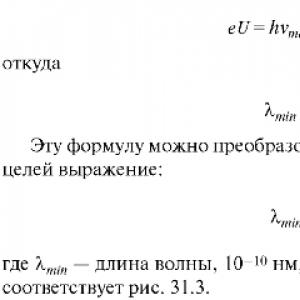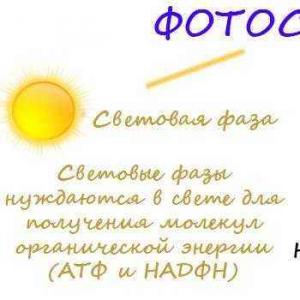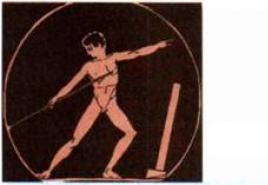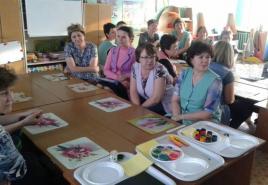Viruses are non-cellular life forms. Their meaning
1. Give definitions of concepts.
Capsid– protective protein shell of the virus.
Bacteriophage
- a virus that infects bacteria.
Retrovirus– a virus whose genetic material is RNA.
2. Draw a diagram of the structure of the virus and label its parts.
4. Using the material in § 2.11 and Figure 42 on p. 80, describe the life cycle of a bacteriophage.
1) The phage approaches the bacterium, and the tail filaments bind to receptor sites on the surface of the bacterial cell.
2) The nucleic acid of the virus (DNA or RNA) is introduced into the bacterial cell.
3) The phage nucleic acid encodes the synthesis of phage enzymes; the host DNA and RNA are inactivated, and the phage enzymes completely break it down; The phage NK subjugates the cellular apparatus.
5) The phage nucleic acid replicates and encodes the synthesis of new envelope proteins.
6) New phage particles are formed as a result of self-assembly of the protein shell around
phage nucleic acid.
7) The cell bursts; new phages are released and infect other bacteria.
5. What are the features of the life cycle of the human immunodeficiency virus?
The AIDS virus – HIV – is a retrovirus. Its genetic material is RNA. HIV attacks the cells of the immune system. Upon entry into the host cell, reverse transcription occurs, during which DNA is synthesized from the viral RNA, which is then integrated into the host cell (into the DNA of the host cell). Then, when the cell divides, at the same time that the cellular DNA is copied, the viral DNA is also copied. After a certain time, cells begin to synthesize viral RNA and proteins, from which viral particles are assembled.
HIV thus destroys lymphocytes - T-helpers. As a result, the human immune system is destroyed.
6. Based on the material you have studied, comment on the statement of scientists: “Viruses are bad news in a protein package.”
Viruses have a protein shell called a capsid.
Viruses cause dangerous and sometimes fatal diseases.
7. Indicate the main measures to prevent HIV infection.
Avoid casual sex.
Use a condom during sexual intercourse
In hospitals, clinics, and beauty salons, use only disposable syringes, and use reusable instruments carefully.
sterilize.
Donated blood is checked for the presence of antibodies to HIV.
8. In modern media, the terms “HIV” and “AIDS” are often used interchangeably. Is such interchange possible? If not, explain why.
No, because HIV is the human immunodeficiency virus, and AIDS is acquired immunodeficiency syndrome, the last stage of HIV infection. Some people, with quality supportive treatment, can live with HIV for 20 years or more without developing AIDS.
9. Explain the evolutionary role of viruses in nature.
Viruses correct the course of evolution. Viruses use pandemics to exterminate and weaken certain phenotypes that no longer participate in the evolutionary process.
About 20% of human genetic material is introduced by viruses. Sometimes viral genes become cellular genes.
Viruses can not only change the genetic apparatus of a cell, but also exchange genetic information within a species and between different groups of organisms. In a changing external environment, this is a powerful evolutionary mechanism. That is, viruses stimulate evolutionary processes in the biosphere.
10. The word “viruses” translated from Latin means “poison”. Why did viruses get this name?
Viruses lead the body to a state in which healthy cells produce copies of viruses, while the natural regulation of metabolism is disrupted and the normal process of removing waste products from cells is disrupted. Hence the effect of toxic poisoning, which is inherent in any viral infection.
11. Choose the correct answer.
Test 1.
The human immunodeficiency virus differs from Vibrio cholerae:
3) lack of DNA;
Test 2.
They do not have a cellular structure:
4) viruses.
12. Match viruses with the cells they infect.
Viruses
1. Bacteriophage
2. Tobacco mosaic virus
3. Smallpox virus
4. Polio virus
5. HIV
The cells they infect
A. Tobacco plant cells
B. Leukocytes
B. Nerve tissue cells
G. Bacteria
D. Epithelial cells
13. Explain the origin and general meaning of the word (term), based on the meaning of the roots that make it up.

14. Select a term and explain how its modern meaning matches the original meaning of its roots.
The chosen term is bacteriophage.
Conformity - the term does not exactly correspond to the original meaning. A bacteriophage is a virus that infects bacteria but does not consume them.
15. Formulate and write down the main ideas of § 2.11.
Viruses are non-cellular life forms. Viruses cause diseases, often incurable. But at the same time, viruses are important for the evolutionary process, as they stimulate it and introduce new genetic information into cells.
There are RNA and DNA viruses. The first ones are called retroviruses. These include HIV. When a retrovirus enters a host cell, reverse transcription occurs, during which DNA is synthesized from viral RNA, which is then integrated into the host cell.
There are bacteriophages - viruses that infect bacteria, human, plant and animal viruses.
A viral particle consists of a protein shell (capsid) and a nucleic acid (RNA or DNA) inside.
Questions for the test on the topic “Molecular level”. What is a monomer? What is a polymer? List the levels of organization of living matter. Name three characteristics that characterize living matter. Finish the phrase: “Viruses are... a form of life.” Name a substance that carries information about the characteristics of an organism. Among the functions listed below, name those that are characteristic of proteins: a) construction; b) the environment in which biochemical processes occur; c) energy; d) catalytic; and,) solvent. Monomer of nucleic acids - ... Name the universal energy accumulator in the cell. List the elements that are classified as macroelements according to their content in the cell. Complete the sentence: “Protein monomers are...”. The most energy-intensive are: a) fats; b) nucleins; acids; c) proteins; d) carbohydrates. List the nitrogenous bases that are characteristic of DNA. Name the compounds that belong to polymers. What determine the properties of biopolymers? What does the presence of the same chemical elements in living and inanimate bodies indicate? From the listed carbohydrates, select monosaccharides: glycogen, ribose, sucrose, cellulose, glucose. What organic substances contain ribose? Which compound is a starch monomer? What are the biological functions of lipids? What compounds are lipids related to water? What is the primary structure of a protein formed by? What are enzymes? What bonds support the secondary structure of a protein? What is denaturation? The composition of DNA differs from RNA in the content of: a) sugar, b) nitrogenous bases; c) sugars and nitrogenous bases. List the levels of protein organization. What are vitamins? What is the role of enzymes in a cell? Why does the cell's vital activity stop when the enzyme structure is destroyed? What factors determine the rate of enzymatic reactions? Using your knowledge of the functions of proteins in cells, explain the statement that proteins are the basis of life. The secondary structure of the protein is maintained by: a) peptides; connections; b) hydrogen bonds; c) disulfide covalent bonds. Which of the following chemical compounds is not a biopolymer: a) protein; b) glucose; c) DNA; d) cellulose? Eliminate unnecessary things: cellulose, starch, glycogen, glucose. List the most important functions of protein. What compounds make up one DNA nucleotide? List the types of RNA. What compounds does ATP consist of? Which nucleotide is missing in the RNA macromolecule: a) adenyl nucleotide; b) thymidyl nucleotide; c) uridyl nucleotide; d) guanyl nucleotide; e) cytidyl nucleotide? Which nucleotides are complementary to cytidyl nucleotide: a) adenyl; b) guanyl; c) uridyl; d) thymidyl? Some enzymes are active only in the presence of vitamins. Why? In which enzyme center do vitamins work? What connection is called macroergic? Walruses, seals and other northern animals accumulate a thick layer of subcutaneous fat in their bodies. What functions does it perform in the body of these animals? What bonds support the secondary structure of DNA? Decipher the full name of DNA. What is the tertiary structure of a protein? Identify a specific relationship between the first and second word; the same connection exists between the third word and one of the concepts below. Find him. cellulose: glucose = protein:... a) nucleotide; b) glycerin; c) amino acid; d) lipid.
Slide 20 from the presentation “Elective course in biology”Dimensions: 720 x 540 pixels, format: .jpg. To download a slide for free to use in class, right-click on the image and click “Save Image As...”. You can download the entire presentation “Elective course in biology.ppt” in a zip archive of 3723 KB in size.
Biology training
"UMK in biology" - Reference materials on biology. Tasks are developed for each paragraph. Authors of teaching materials in biology. Tasks of a cognitive and educational nature. Denis Diderot. Legislative change in the structure of the standard. The structure of the notebook reflects the structure of the textbook. THE TEXTBOOK is the core of the set. Forms generalized methods of action when mastering basic biological concepts.
“Project activity” - Project activity in the classroom. The use of computer technology in teaching biology. Computer technologies and design activities. Presentation layout. Stages of a teacher's work. Designing a biology lesson. Theory and practice. (technology of project activities). Internet addresses. Theory and practice. (technology of project activities, Parameters).
“Training work” - Main results of research work. Publishing activities. Ecology % directed. Distribution of EBF graduates. Educational work. Preparation of curricula for undergraduate programs. Scientific publications. Results of the session. Opening of the specialization “Molecular Biology” (specialty “Biology”).
“Biology program” - Biology (basic school). Natural history. Biology of Plants. Publications on electronic media. Biology Human. 8th grade (authors A.G. Dragomilov, R.D. Mash). Methodological literature. Flashcards. Biology Basics of general biology. 9th grade (authors I.N. Ponomareva, O.A. Kornilova, N.M. Chernova).
Profile self-determination
Her Majesty DNA Municipal educational institution Secondary school No. 23 PRE-PROFILE COURSE (9th grade) Compiled by: biology teacher Kucherenko E.V.
x Secret materials about your health pre-profile course
The concept of the program provides for real practice-oriented activities of students in environmental assessment of the environment, which provides ample opportunities for students’ self-development, their implementation of socially significant projects and the real improvement of the environmental condition of their environment. This activity will contribute to the socialization of schoolchildren, the development of their citizenship and active life position. The program provides 11 theoretical and 6 practical classes aimed at studying certain physiological characteristics of the human body, its health, and compliance with hygiene rules.
Course goal 1. Mastering the methods and methods of assessing the ecological state of the environment and its individual components. 2. Mastery of knowledge, skills to observe and evaluate the state of health, heredity, lifestyle and environment, using measurements and experiments. 3. Disclosure and deepening of environmental concepts. 3. Development of skills and habits of environmentally literate behavior in the environment, with other people, harmonious interaction and sustainable development in the “Nature – Society – Health” system
Course content: Health and population Health and heredity Healthy lifestyle Human living environment Health is a state of complete physical, mental and spiritual well-being. The problem of maintaining health is one of the most pressing problems for the younger generation. Modern statisticians have calculated that health depends 20% on living conditions (ecology), another 20% on heredity, 10% on medicine, and 50% on lifestyle.
Health and population Current status and forecast of population growth (million people) 10 largest countries in the world. Growth of the Earth's population Possible growth curve of the Earth's population
Health and heredity What is human ancestry? This is the story of the family. The pedigree determines the origin of a person and the degree of relationship. From generation to generation, features of appearance, character traits, inclination towards a certain profession and various diseases are passed on. According to statistics, 2-3% of children are born with disorders, and 1/3 of them have congenital disorders.
Healthy lifestyle Hygiene and health, Sports, hardening, work Herbs, vegetables and fruits go hand in hand.
Bad habits Light a cigarette - You will be “beautiful”: Yellow-toothed old ladies With sad faces...
Municipal educational institution Secondary school No. 23 Elective course “Selected Issues of Biology” Oktyabrsky (from) district of Krasnogornyatsky village 2009
The purpose of the course is the formation of generalized knowledge and cognitive skills, sustainable interest in biology; broadening their horizons, raising the general cultural level of students; vocational guidance and profiling of students.
Forms and methods of the course.
Expected Result. Type: “Man – man” Type: “Man – nature” Biologist teacher health workers Agronomist Ecologist Veterinarian
Teacher's tasks:
"REPRODUCTION AND INDIVIDUAL DEVELOPMENT OF ORGANISMS."
Self-control sheet__________________________________________________________ On the topic “Main components and organelles of cells.”
Questions for the test on the topic “Molecular level”. What is a monomer? What is a polymer? List the levels of organization of living matter. Name three characteristics that characterize living matter. Finish the phrase: “Viruses are... a form of life.” Name a substance that carries information about the characteristics of an organism. Among the functions listed below, name those that are characteristic of proteins: a) construction; b) the environment in which biochemical processes occur; c) energy; d) catalytic; and,) solvent. Monomer of nucleic acids - ... Name the universal energy accumulator in the cell. List the elements that are classified as macroelements according to their content in the cell. Complete the sentence: “Protein monomers are...”. The most energy-intensive are: a) fats; b) nucleins; acids; c) proteins; d) carbohydrates. List the nitrogenous bases that are characteristic of DNA. Name the compounds that belong to polymers. What determine the properties of biopolymers? What does the presence of the same chemical elements in living and inanimate bodies indicate? From the listed carbohydrates, select monosaccharides: glycogen, ribose, sucrose, cellulose, glucose. What organic substances contain ribose? Which compound is a starch monomer? What are the biological functions of lipids? What compounds are lipids related to water? What is the primary structure of a protein formed by? What are enzymes? What bonds support the secondary structure of a protein? What is denaturation? The composition of DNA differs from RNA in the content of: a) sugar, b) nitrogenous bases; c) sugars and nitrogenous bases. List the levels of protein organization. What are vitamins? What is the role of enzymes in a cell? Why does the cell's vital activity stop when the enzyme structure is destroyed? What factors determine the rate of enzymatic reactions? Using your knowledge of the functions of proteins in cells, explain the statement that proteins are the basis of life. The secondary structure of the protein is maintained by: a) peptides; connections; b) hydrogen bonds; c) disulfide covalent bonds. Which of the following chemical compounds is not a biopolymer: a) protein; b) glucose; c) DNA; d) cellulose? Eliminate unnecessary things: cellulose, starch, glycogen, glucose. List the most important functions of protein. What compounds make up one DNA nucleotide? List the types of RNA. What compounds does ATP consist of? Which nucleotide is missing in the RNA macromolecule: a) adenyl nucleotide; b) thymidyl nucleotide; c) uridyl nucleotide; d) guanyl nucleotide; e) cytidyl nucleotide? Which nucleotides are complementary to cytidyl nucleotide: a) adenyl; b) guanyl; c) uridyl; d) thymidyl? Some enzymes are active only in the presence of vitamins. Why? In which enzyme center do vitamins work? What connection is called macroergic? Walruses, seals and other northern animals accumulate a thick layer of subcutaneous fat in their bodies. What functions does it perform in the body of these animals? What bonds support the secondary structure of DNA? Decipher the full name of DNA. What is the tertiary structure of a protein? Identify a specific relationship between the first and second word; the same connection exists between the third word and one of the concepts below. Find him. cellulose: glucose = protein:... a) nucleotide; b) glycerin; c) amino acid; d) lipid.


The concept of the program provides for real practice-oriented activities of students in environmental assessment of the environment, which provides ample opportunities for students’ self-development, their implementation of socially significant projects and the real improvement of the environmental condition of their environment.
This activity will contribute to the socialization of schoolchildren, the development of their citizenship and active life position.
The program provides 11 theoretical and 6 practical classes aimed at studying certain physiological characteristics of the human body, its health, and compliance with hygiene rules.

1. Mastering methods and techniques for assessing the ecological state of the environment and its individual components.
2. Mastery of knowledge, skills to observe and evaluate the state of health, heredity, lifestyle and environment, using measurements and experiments.
3. Disclosure and deepening of environmental concepts.
3. Development of skills and habits of environmentally literate behavior in the environment, with other people, harmonious interaction and sustainable development in the “Nature – Society – Health” system











What is a monomer?
What is a monomer?
What is a polymer?
List the levels of organization of living matter.
Name three characteristics that characterize living matter.
Complete the sentence: “Viruses are... a form of life.”
Name a substance that carries information about the characteristics of an organism.
Among the functions listed below, name those that are characteristic of proteins: a) construction; b) the environment in which biochemical processes occur; c) energy; d) catalytic; and,) solvent.
Monomer of nucleic acids -...
Name the universal energy accumulator in a cell.
List the elements that are classified as macroelements according to their content in the cell.
Complete the sentence: “Protein monomers are...”.
The most energy-intensive are: a) fats; b) nucleins; acids; c) proteins; d) carbohydrates.
List the nitrogenous bases that are characteristic of DNA.
Name the compounds that belong to polymers.
What determine the properties of biopolymers?
What does the presence of the same chemical elements in living and inanimate bodies indicate?
From the listed carbohydrates, select monosaccharides: glycogen, ribose, sucrose, cellulose, glucose.
What organic substances contain ribose?
Which compound is a starch monomer?
What are the biological functions of lipids?
What compounds are lipids related to water?
What is the primary structure of a protein formed by?
What are enzymes?
What bonds support the secondary structure of a protein?
What is denaturation?
The composition of DNA differs from RNA in the content of: a) sugar, b) nitrogenous bases; c) sugars and nitrogenous bases.
List the levels of protein organization.
What are vitamins?
What is the role of enzymes in a cell?
Why does the cell's vital activity stop when the enzyme structure is destroyed?
What factors determine the rate of enzymatic reactions?
Using your knowledge of the functions of proteins in cells, explain the statement that proteins are the basis of life.
The secondary structure of the protein is maintained by: a) peptides; connections; b) hydrogen bonds; c) disulfide covalent bonds.
Which of the following chemical compounds is not a biopolymer: a) protein; b) glucose; c) DNA; d) cellulose?
Eliminate unnecessary things: cellulose, starch, glycogen, glucose.
List the most important functions of protein.
What compounds make up one DNA nucleotide?
List the types of RNA.
What compounds does ATP consist of?
Which nucleotide is missing in the RNA macromolecule: a) adenyl nucleotide; b) thymidyl nucleotide; c) uridyl nucleotide; d) guanyl nucleotide; e) cytidyl nucleotide?
Which nucleotides are complementary to cytidyl nucleotide: a) adenyl; b) guanyl; c) uridyl; d) thymidyl?
Some enzymes are active only in the presence of vitamins. Why?
In which enzyme center do vitamins work?
-
Viruses are contagious, tiny, and pretty nasty. But are they alive?
Not really, although it depends on what you mean by "live". Living things such as plants and animals contain cellular machinery that allows them to reproduce themselves. Viruses are free forms of DNA or RNA that cannot reproduce on their own.
"Viruses most likely must invade a living organism to have the ability to reproduce," said Dr. Otto Young, professor of medicine and microbiology, immunology and molecular genetics at the University of California, Los Angeles School of Medicine.
Viruses are made of RNA or DNA. They simply copy themselves, hijacking the cells' machinery for their own replication.
Characteristics of life
Countless philosophers and scientists have discussed how to determine whether an object is alive. According to the accepted characterization of life, all living things must be able to respond to stimuli, grow over time, produce offspring, maintain a stable body temperature, metabolize energy, be composed of one or more elementary cells, and adapt to their environment.

However, there is a life form that does not fit each of these characteristics. Most hybrid animals, such as mules (crossbreeds between donkeys and horses), cannot reproduce because they are sterile. In addition, stones can grow, albeit in a passive way, with the help of new material flowing through them. But this problem of classification goes away when a simpler definition of life is used.
Simple definitions of life
“Take a cat, a plant and a rock and leave them in a room for a few days,” said Amesh Adalja, a physician and researcher at the Johns Hopkins Center for Health Security in Baltimore. “When you return, the cat and the plant will have changed, but the rock will have changed.” will essentially remain the same."

Like stone, most viruses will remain unchanged if left indefinitely in a room. In addition, the scientist noted that living beings are distinguished by self-generated and self-sufficient actions. This means they can look for a livelihood and behave in a way that keeps them safe. In other words, they take the measures necessary to maintain further life. For example, a plant uses its roots to find water, and an animal can go in search of food.
Unlike plants or animals, viruses are not capable of self-generating or self-sufficient actions.

Inert objects
Dr. Adalja believes that viruses cannot be classified as living organisms. They are essentially inert unless they come into contact with a living cell. There are some characteristics of viruses that define their place on the border with living things: they have genetic material - DNA or RNA. Thus, viruses cannot be called non-living, like, for example, a stone, but at the same time, scientists cannot classify them as living beings. In fact, they can't even reach bacteria levels.
It all depends on your point of view
Dr. Yang agrees with these findings. He says that without a cell, the virus cannot reproduce. From this point of view, viruses are truly non-living, if you consider that the main characteristic of life is its ability to reproduce itself independently of other conditions.

However, if your definition of life depends on whether an object can make copies of itself with the help of others, then viruses can definitely be called living.
It is believed that the very first forms of life on Earth were RNA-like molecules. Given the right conditions, they could make copies of themselves. Viruses may have evolved from this ancestor, but have lost the ability to reproduce themselves.
Similar articles







